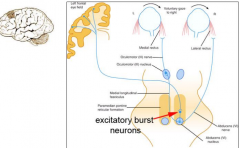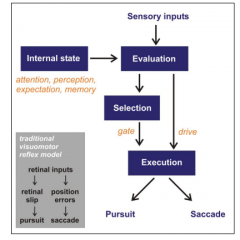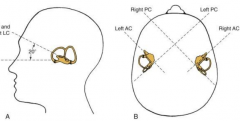![]()
![]()
![]()
Use LEFT and RIGHT arrow keys to navigate between flashcards;
Use UP and DOWN arrow keys to flip the card;
H to show hint;
A reads text to speech;
33 Cards in this Set
- Front
- Back
|
What is the goal of eye movements?
|
To maintain alignment of the two foveae onobjects of interest in the visual field.
|
|
|
What happens if they are not aligned?
|
Misalignment of the eyes results in failure of a point ofvisual interest to fall on the same region of each retina.
Adults: diplopia or “double vision” Children: if untreated can developpermanent vision loss. |
|
|
What is fixation? |
Fixation: Maintenance of focus on a particular spot in thevisual world.
In other words, the eyes need tostay motionless for a brief moment in order for youto see mountains in the distance, for example, or aletter on a page of text. Primary position of gaze |
|
|
What are saccades? |
Saccades: Rapid conjugate shifts in gaze attention.
These are the fastest movements human muscles can make – up to 660-900 degrees/sec |
|
|
What is smooth pursuit? |
Smooth pursuit: Continued fixation on slowly movingobjects when the head is stationary.
|
|
|
What is the vistibulo-ocular reflex? |
Vestibulo-ocular reflex (VOR): Fixation on a stationaryobject during brief head movements.
Keeps the visual world stable on the foveae. |
|
|
What is optokinetic nystagmus? |
Optokinetic nystagmus (OKN): Fixation on stationaryimages during sustained head rotations or continuedsmall eye movements for moving images in the visualfield.
Allows you to fixate your vision on stationaryimages during sustained head rotations, or usesaccades to follow moving images. |
|
|
What is the vergence system? |
Vergence system : For viewing close stationary objects -head is stationary. Eye both turn toward midline.
|
|
|
What is the goal of all these systems?
|
To ensure a stable image of the same partof the visual world on the same parts ofeach retina.
|
|
|
What are conjugate movements? |
Conjugate movements: eyes move in the same direction at the same time.
|
|
|
What are disconjugate movements? |
• Disconjugate movements: eyes do NOT movein the same direction at the same time, butstill move the same amount in a coordinatedmanner – just in the opposite direction fromeach other.
– Vergence movements (near vision) |
|
|
Extraocular muscles and the nerves that control them:
|
six per orbit
In each orbit: 4 rectus muscles: superior, medial, inferior, lateral 2 oblique muscles: superior, inferior Cranial motor nerves of oculomotor (CNIII), trochlear (CNIV), and abducens (CNVI) neurons in the brainstem These motor neurons control bothposition and velocity of eye movements. |
|
|
What is agonist/antagonist pair in rectus muscles? |
The lateral and medial rectus muscles attached oneach side of the globe form an agonist/antagonistpair. When one contracts (agonist), the other relaxes.
|
|
|
What are yoked muscles (rectus)? |
Each pair of medial and lateral rectus muscles,attached to the same side as the direction ofmovement in each orbit forms a yoked muscle pair.Both contract in unison.
|
|
|
What nerves innervate the extraocular muscles? |
The trochlear nerve (cranial nerve 4 - CNIV)innervates the superior oblique muscle.
The abducens nerve (cranial nerve 6 - CNVI)innervates the lateral rectus muscle. The oculomotor nerve (cranial nerve 3 – CNIII) innervates theother four muscles: superior rectus, medial rectus, inferior rectusand inferior oblique – plus the levator palpebrae superioris. |
|
|
What kind of eye movement are saccades and what are they used for? |
Saccades are fast, yoked eye movements that move the eyequickly from fixation to a new position of gaze.
Used for:• Quick phase of VOR and OKN (head moves, eyes move inopposite direction)• Shift gaze in response to a novel stimulus in the visualfield• Shift gaze during reading• Search novel scenes• Return gaze to remembered locations |
|
|
How do you look right with your eyes? |
Excitation of the lateral rectus of the right eye andthe medial rectus of the left eye by neuronsin the abducens and oculomotor nuclei
|
|
|
How Neurons Move yourEyes to Fixate on a New Object
|
Pulse: burst in firing rateDetermines velocity and eye position
Step: tonic firingDetermines fixation period |
|
|
What Brain Region Controls the Motor Neuronsin Horizontal Gaze Shift?
|

Frontal eye field neurons in the cerebral cortex project to excitatoryburst neurons, and these project to the motor neurons.
|
|
|
Ultimately all eye movements that involve saccadesand smooth pursuit are initiated in the cortex.
|

|
|
|
Vertical eye movement |
Muscle - Primary
Superior rectus-Elevation: eye looks up Inferior rectus-Depression: eye looks down Superior oblique-Eye looks down and out Inferior oblique-Eye looks up and out |
|
|
What is Vestibular Ocular Reflex (VOR)? |
Stabilization of Gaze Relative to Head Movement
Note that the eyes move in the opposite direction to that of yourhead, and the image of the visual world remains stable despite thehead movement. This is why the world looks stationary despite walking and running. |
|
|
Why is moving text difficult to read? |
If you move a book in front of your stationary head, the text wouldnot be clear. This is because visual processing is much slower thanvestibular processing.
The VOR has a very short latency, between 7-15milliseconds,because it is mediated by only 3 neurons. It is accurate for velocitiesin excess of 300 degrees/second. |
|
|
What are the vestibular end organs and what do they monitor? |
The VOR is thanks to your vestibular end organs: three semicircular canals whichmonitor angular head acceleration and two otolith organs (saccule and utricle) whichmonitor linear acceleration and head orientation. |
|

|
The horizontal canals are in the plane of horizontal muscles(medial and lateral rectus).
The hair cells located in theirampules send information to the brain about head acceleration. Each side sends either excitatory or inhibitory information viaprojections to the vestibular nuclei, which in turn project to themotor nuclei . |
|
|
3 neuron arc |
Leftward head movement excites left horizontal semicircular canal, which sends excitatoryinput to left vestibular nuclear neurons. These send excitatory signals to left oculomotor nucleusand the right abducens nucleus and inhibitory signals to the right oculomotor nucleus and theleft abducens nucleus. These in turn send excitatory signals to the left medial rectus andright lateral rectus muscles and inhibitory signals to the left lateral rectus and right medialrectus muscles. This pathway is FAST and does not require vision.
|
|
|
What if the head moves too fast for the VOR?
|
You get optokinetic nystagmus (OKN).
Optokinetic Nystagmus Habituates(Decreases) with Continued Rotation In darkness, the vestibular nystagmus response decays as thesemicircular canals (SCC) habituate to a constant rotation (i.e., zeroacceleration). Nystagmus due to constant rotation in lightedconditions will not decay, due to the continued visual input to theocular motor system. |
|
|
How do you read? |
In reading, you fixate, make a quick movement (saccade), refixate,make another saccade, etc. We only perceive what we see duringthe fixation period; no perception is present during saccades |
|
|
What type of movements do your eyes make when youwant to change your fixation point in the distance?
|
Saccades!
|
|
|
What type of eye movements are made if anobject is moving in the visual world and you arestationary?
|
Smooth Pursuit
|
|
|
What type of eye movements are made if you wantto look at something close up (like a book)?
|
Vergence
|
|
|
Strabismus
|
3-5% of children have strabismus.• There is a critical period during development of binocularvision. The conjugacy of eye movements must be restoredprior to this time (usually by 8-10 years) for normal visualacuity.• Untreated strabismus can lead to loss of functional visionin the turned eye, called amblyopia or lazy eye.
Can be caused by a mutation in the alpha2-chimaeringene that has been implicated in axon pathfinding. |
|
|
Infantile Nystagmus Syndrome
|
Involuntary eye oscillations that prevent stableimages from forming on the retina
|

